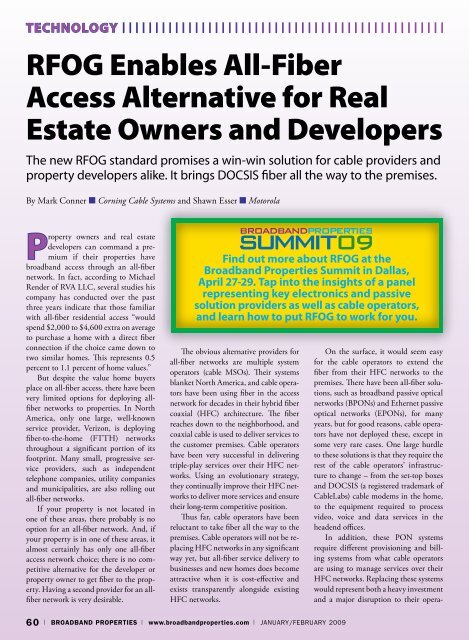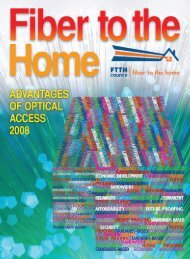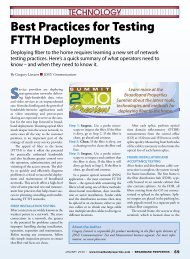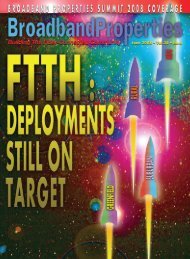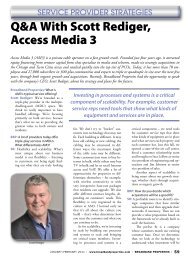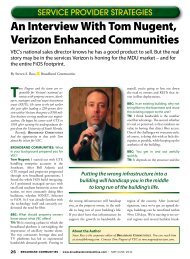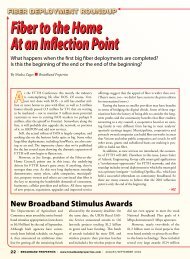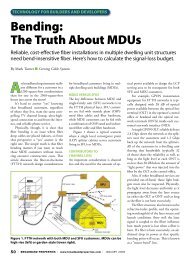bbpmag.com - Broadband Properties
bbpmag.com - Broadband Properties
bbpmag.com - Broadband Properties
Create successful ePaper yourself
Turn your PDF publications into a flip-book with our unique Google optimized e-Paper software.
TECHNOLOGY<br />
RFOG Enables All-Fiber<br />
Access Alternative for Real<br />
Estate Owners and Developers<br />
The new RFOG standard promises a win-win solution for cable providers and<br />
property developers alike. It brings DOCSIS fiber all the way to the premises.<br />
By Mark Conner ■ Corning Cable Systems and Shawn Esser ■ Motorola<br />
Property owners and real estate<br />
developers can <strong>com</strong>mand a premium<br />
if their properties have<br />
broadband access through an all-fiber<br />
network. In fact, according to Michael<br />
Render of RVA LLC, several studies his<br />
<strong>com</strong>pany has conducted over the past<br />
three years indicate that those familiar<br />
with all-fiber residential access “would<br />
spend $2,000 to $4,600 extra on average<br />
to purchase a home with a direct fiber<br />
connection if the choice came down to<br />
two similar homes. This represents 0.5<br />
percent to 1.1 percent of home values.”<br />
But despite the value home buyers<br />
place on all-fiber access, there have been<br />
very limited options for deploying allfiber<br />
networks to properties. In North<br />
America, only one large, well-known<br />
service provider, Verizon, is deploying<br />
fiber-to-the-home (FTTH) networks<br />
throughout a significant portion of its<br />
footprint. Many small, progressive service<br />
providers, such as independent<br />
telephone <strong>com</strong>panies, utility <strong>com</strong>panies<br />
and municipalities, are also rolling out<br />
all-fiber networks.<br />
If your property is not located in<br />
one of these areas, there probably is no<br />
option for an all-fiber network. And, if<br />
your property is in one of these areas, it<br />
almost certainly has only one all-fiber<br />
access network choice; there is no <strong>com</strong>petitive<br />
alternative for the developer or<br />
property owner to get fiber to the property.<br />
Having a second provider for an allfiber<br />
network is very desirable.<br />
Find out more about RFOG at the<br />
<strong>Broadband</strong> <strong>Properties</strong> Summit in Dallas,<br />
April 27-29. Tap into the insights of a panel<br />
representing key electronics and passive<br />
solution providers as well as cable operators,<br />
and learn how to put RFOG to work for you.<br />
The obvious alternative providers for<br />
all-fiber networks are multiple system<br />
operators (cable MSOs). Their systems<br />
blanket North America, and cable operators<br />
have been using fiber in the access<br />
network for decades in their hybrid fiber<br />
coaxial (HFC) architecture. The fiber<br />
reaches down to the neighborhood, and<br />
coaxial cable is used to deliver services to<br />
the customer premises. Cable operators<br />
have been very successful in delivering<br />
triple-play services over their HFC networks.<br />
Using an evolutionary strategy,<br />
they continually improve their HFC networks<br />
to deliver more services and ensure<br />
their long-term <strong>com</strong>petitive position.<br />
Thus far, cable operators have been<br />
reluctant to take fiber all the way to the<br />
premises. Cable operators will not be replacing<br />
HFC networks in any significant<br />
way yet, but all-fiber service delivery to<br />
businesses and new homes does be<strong>com</strong>e<br />
attractive when it is cost-effective and<br />
exists transparently alongside existing<br />
HFC networks.<br />
On the surface, it would seem easy<br />
for the cable operators to extend the<br />
fiber from their HFC networks to the<br />
premises. There have been all-fiber solutions,<br />
such as broadband passive optical<br />
networks (BPONs) and Ethernet passive<br />
optical networks (EPONs), for many<br />
years, but for good reasons, cable operators<br />
have not deployed these, except in<br />
some very rare cases. One large hurdle<br />
to these solutions is that they require the<br />
rest of the cable operators’ infrastructure<br />
to change – from the set-top boxes<br />
and DOCSIS (a registered trademark of<br />
CableLabs) cable modems in the home,<br />
to the equipment required to process<br />
video, voice and data services in the<br />
headend offices.<br />
In addition, these PON systems<br />
require different provisioning and billing<br />
systems from what cable operators<br />
are using to manage services over their<br />
HFC networks. Replacing these systems<br />
would represent both a heavy investment<br />
and a major disruption to their opera-<br />
60 | BROADBAND PROPERTIES | www.broadbandproperties.<strong>com</strong> | January/February 2009


